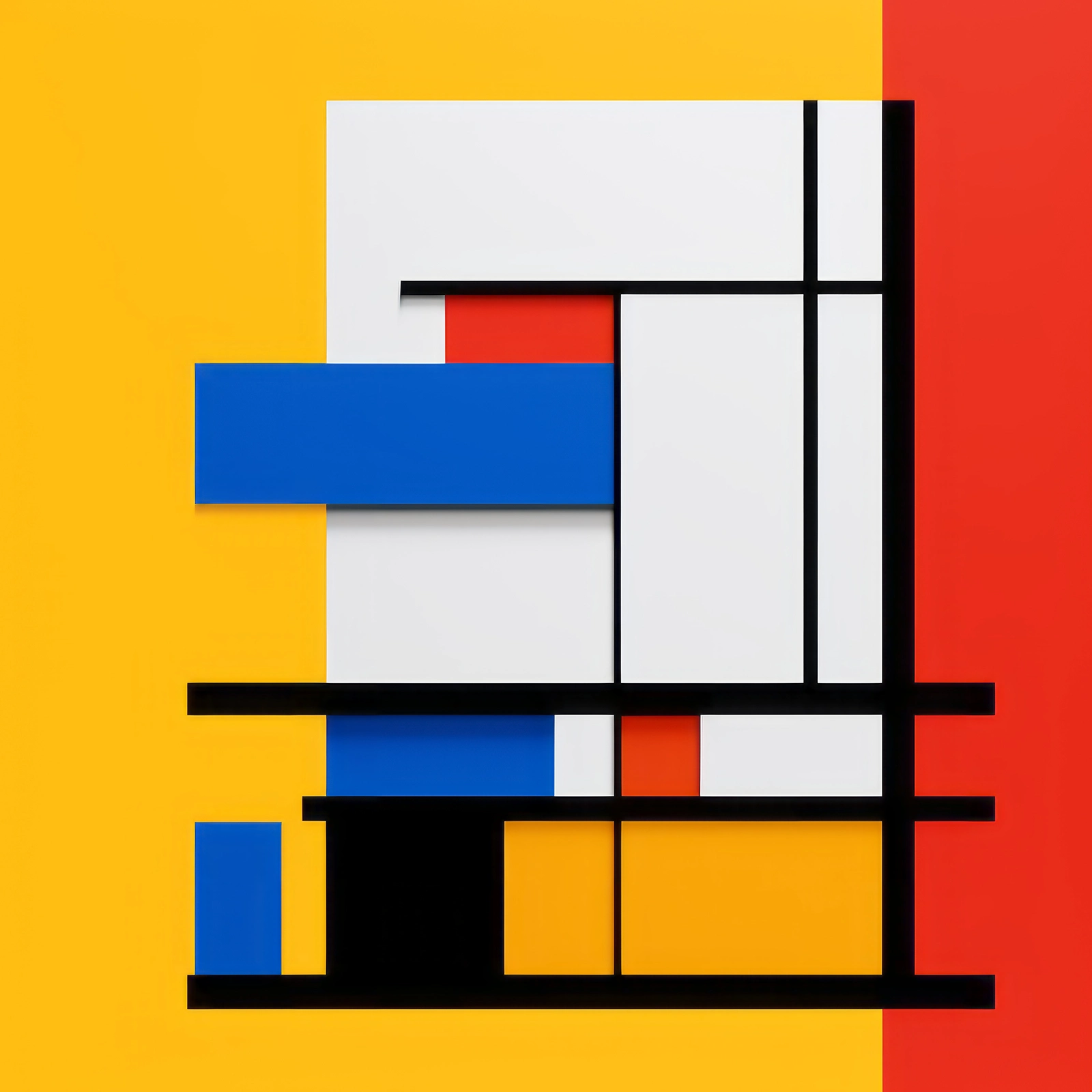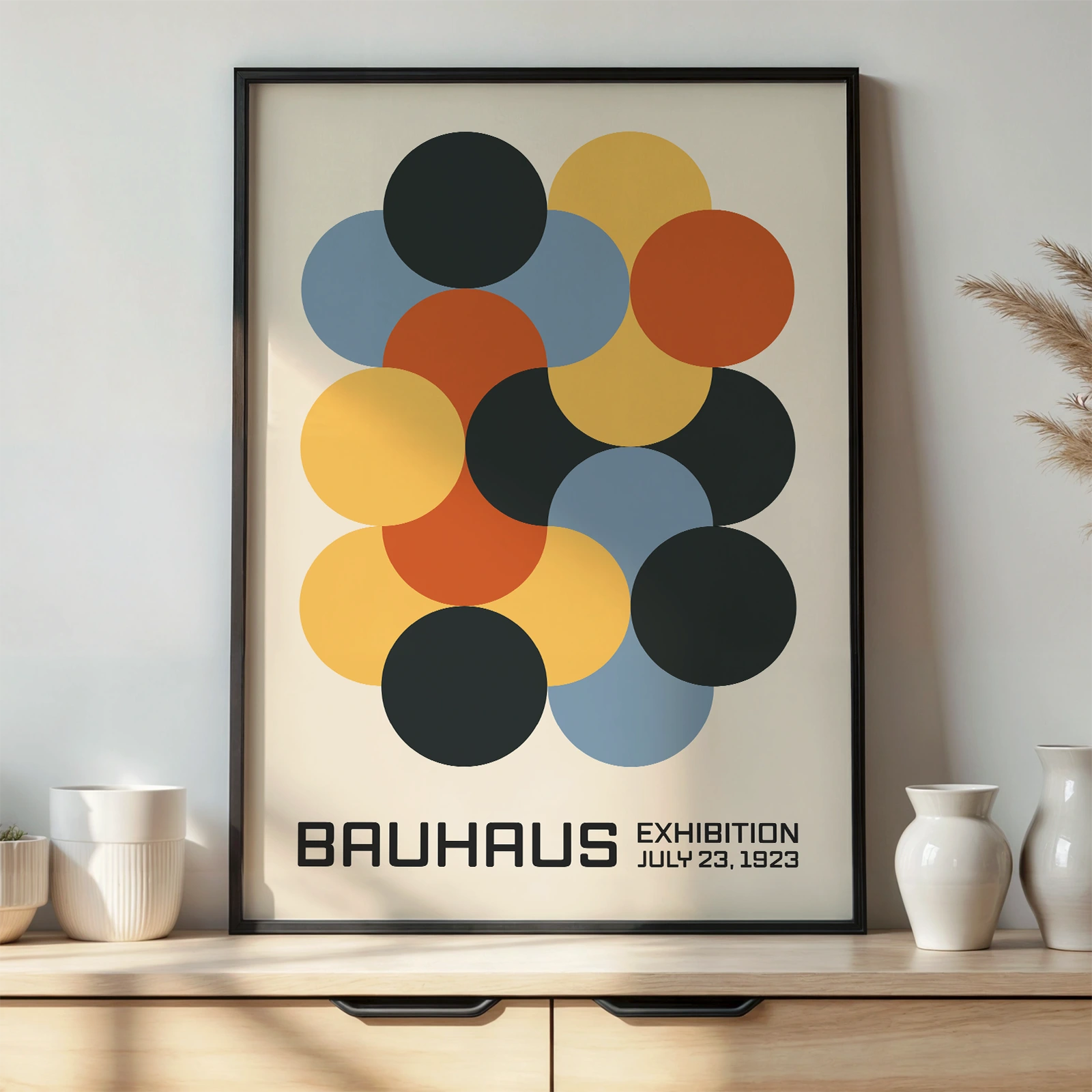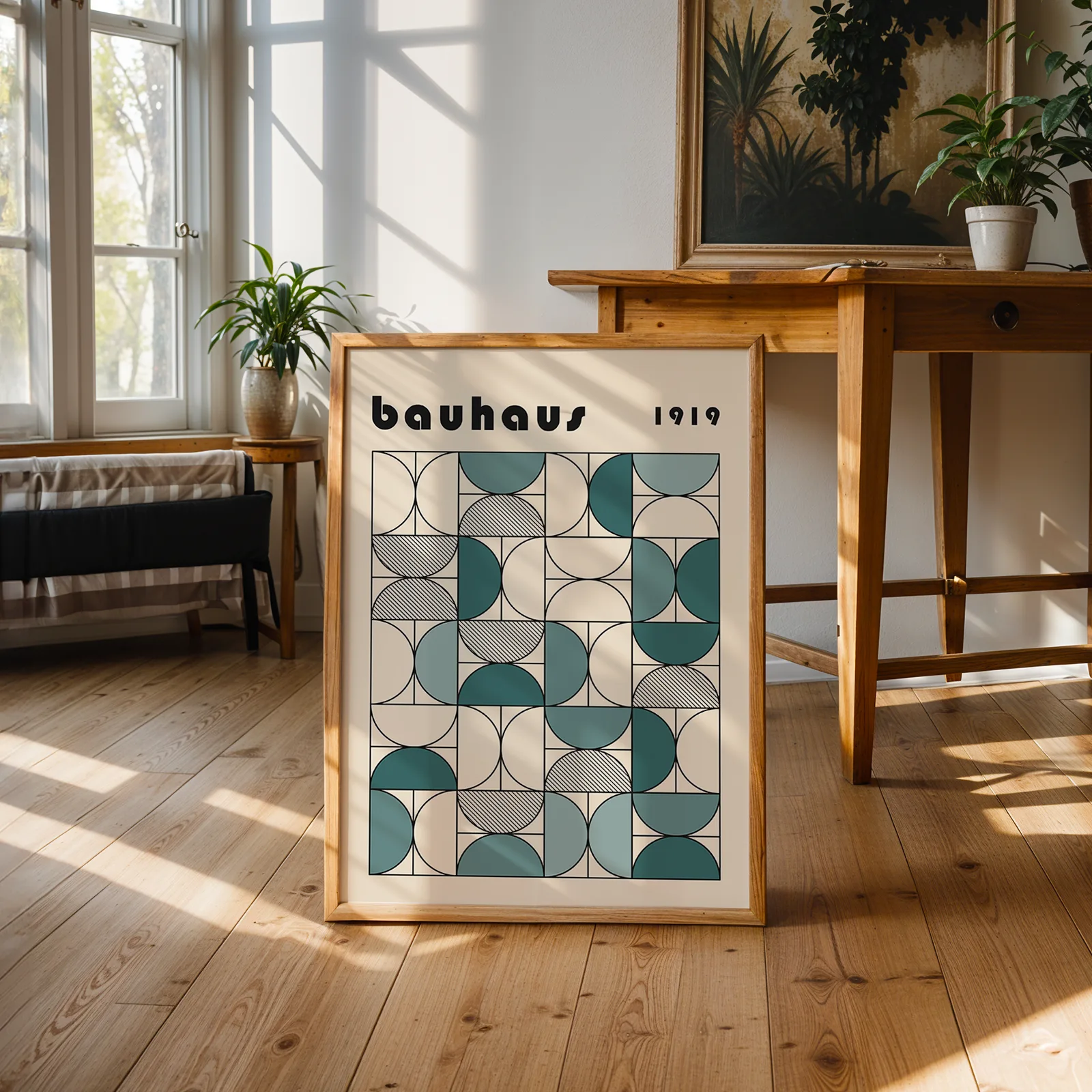Bauhaus Art Prints as a Reflection of 20th Century Design Principles

Bauhaus Art Prints as a Reflection of 20th Century Design Principles
The Bauhaus movement stands as one of the most influential art and design schools of the 20th century, creating a visual language that continues to shape our world today. Bauhaus art prints, with their bold geometric shapes, primary colors, and emphasis on simplicity, represent the revolutionary thinking that transformed how we understand the relationship between art, industry, and function. These distinctive works aren’t merely decorative—they’re physical manifestations of design principles that challenged conventions and established new aesthetic standards.
In this exploration of Bauhaus art prints, we’ll uncover the movement’s origins and core philosophy, analyze its fundamental design principles, examine characteristic motifs and techniques, consider their place in modern interiors, and understand why these iconic designs remain so relevant today. For readers interested in exploring actual examples of these influential works, visit our curated collection of Bauhaus posters that bring bold shapes and vibrant colors to your space.
The Bauhaus movement – origins and philosophy
The Bauhaus movement emerged in 1919 when architect Walter Gropius founded the Staatliches Bauhaus in Weimar, Germany. Born from the ashes of World War I, the Bauhaus school aimed to rebuild society through a radical rethinking of the material world. Gropius envisioned an educational institution that would break down the barriers between fine arts and crafts, creating a new unity between creativity and manufacturing.

At its core, the Bauhaus philosophy embraced the now-famous principle that “form follows function”—the idea that design should prioritize utility and practicality rather than ornate decoration. This approach represented a direct response to the rapid industrialization transforming European society. Rather than rejecting mass production, Bauhaus practitioners sought to harness its potential, creating designs that could be efficiently reproduced while maintaining artistic integrity.
The school moved from Weimar to Dessau in 1925 and finally to Berlin in 1932, where it was forced to close under pressure from the Nazi regime in 1933. Despite its brief existence, the Bauhaus school attracted pioneering artists including Wassily Kandinsky, Paul Klee, Marcel Breuer, and Ludwig Mies van der Rohe, each contributing to its intellectual foundation and visual vocabulary.
This modernist philosophy represented a profound break from historical traditions. Rather than venerating the past, Bauhaus practitioners looked toward the future, embracing industrial materials, mathematical precision, and a belief that good design could improve society. The art prints emerging from this context weren’t merely decorative—they were manifestos for a new way of seeing the world.
Fundamental principles of Bauhaus design in art prints
Bauhaus design principles revolutionized visual communication through a systematic approach that still influences contemporary aesthetics. When examining Bauhaus art prints, six core principles consistently emerge, each contributing to their distinctive appearance and enduring appeal.
Geometric abstraction stands as perhaps the most recognizable element in Bauhaus prints.

Artists reduced complex forms to their essential shapes—circles, triangles, squares, and rectangles—arranged in precise compositions. This geometric language wasn’t arbitrary but reflected the movement’s belief in universal visual communication that transcended cultural boundaries.
Simplicity and clarity define the Bauhaus aesthetic, with designs stripped of unnecessary ornamentation. This minimalist approach emerged from the conviction that excess decoration obscured function and meaning. In Bauhaus prints, every element serves a purpose, creating a visual efficiency that feels remarkably contemporary even a century later.
The color theory developed at the Bauhaus, particularly by Josef Albers and Johannes Itten, emphasized primary colors (red, yellow, blue) along with black, white, and gray. These color choices weren’t merely aesthetic preferences but reflected the school’s interest in psychological effects and optical perception. The strategic use of color creates dynamic tension and movement within the seemingly simple compositions.
Functionality remained central even in purely artistic productions. Bauhaus prints often originated as posters announcing exhibitions, conveying information while embodying the school’s visual principles. This marriage of communication and aesthetics demonstrates how Bauhaus practitioners viewed art as inseparable from everyday life.
Experimentation characterized the Bauhaus workshop environment, with artists exploring novel printing techniques, photomontage, and typographic innovations. This spirit of creative inquiry produced prints that feel perpetually fresh and innovative, constantly pushing against conventional boundaries.
Finally, Bauhaus prints exemplify the school’s commitment to unifying art with technology. By embracing mechanical reproduction rather than one-off artworks, Bauhaus practitioners democratized design, making sophisticated visual thinking accessible to broader audiences.
Modern interpretations in home decor
Contemporary interior designers frequently incorporate Bauhaus-inspired prints to add intellectual depth and visual interest to spaces. Their geometric clarity provides a sophisticated counterpoint to more organic elements, while their bold colors can energize neutral environments.

For those looking to add a bold, creative edge to their walls, try this Bauhaus wall art with colorful geometric pattern inspired by 1923 design.
Bauhaus art prints—key motifs, colors, and techniques
The visual vocabulary of Bauhaus prints reveals a consistent language of forms, colors, and production methods that defined the movement’s aesthetic. Understanding these elements helps us appreciate how these works communicated the school’s revolutionary ideas through purely visual means.
Geometric motifs dominate Bauhaus compositions, with circles, triangles, and squares arranged in dynamic relationships. These elementary shapes weren’t chosen arbitrarily but reflected the movement’s interest in fundamental visual building blocks that could be universally understood. Artists like Wassily Kandinsky developed theories connecting specific shapes to emotional and psychological responses, creating a systematic approach to composition.
Balance in Bauhaus prints typically emerges from asymmetrical rather than symmetrical arrangements. This dynamic equilibrium creates visual tension while maintaining overall harmony, reflecting the movement’s interest in modernist principles that departed from classical conventions. The resulting compositions feel energetic yet controlled, capturing the industrial era’s sense of ordered momentum.
The Bauhaus color palette centered on primary colors (red, yellow, blue) supplemented by black, white, and gray. This restricted range wasn’t a limitation but a disciplined choice reflecting theories developed in the school’s preliminary course. Johannes Itten and later Josef Albers explored how these colors interacted, creating perceptual effects through their juxtaposition. The resulting vibrancy in Bauhaus prints comes not from an extensive palette but from the strategic placement of these fundamental hues.
Production techniques for Bauhaus prints embraced industrial processes rather than traditional fine art methods. Lithography, screen printing, and other mechanical reproduction techniques aligned with the school’s interest in democratizing design. Unlike limited-edition etchings or engravings from earlier artistic traditions, Bauhaus prints could be widely disseminated, reflecting the movement’s social ideals about accessibility.
Typography in Bauhaus prints deserves special attention, as the school pioneered modern approaches to lettering. Herbert Bayer’s universal alphabet and other typographic experiments rejected ornamental fonts in favor of clear, geometric letterforms. Text and image worked together as integrated design elements rather than separate components, creating cohesive visual statements.
Learn how abstract retro posters-modern art prints add color, flow, and edge to your space—a movement in direct dialogue with Bauhaus aesthetics.
Bauhaus art prints in modern interiors
Bauhaus prints have transcended their historical context to become staples in contemporary interior design, offering visual sophistication that complements diverse architectural styles. Their enduring appeal stems from an ability to feel simultaneously historic and timeless.
In residential settings, Bauhaus wall art provides focal points that elevate ordinary rooms into thoughtfully curated spaces. Their bold geometric patterns and vibrant colors create visual anchors that can define a room’s entire aesthetic direction. Designers often position these prints in living areas where they can spark conversation while adding intellectual depth to the environment.
Professional environments including creative offices, architectural firms, and design studios frequently display Bauhaus prints as statements of aesthetic philosophy.

Beyond mere decoration, these works signal an alignment with modernist principles and innovative thinking. The clarity and purpose evident in Bauhaus design translates well to spaces dedicated to productive creativity.
When selecting Bauhaus prints for your space, consider how they’ll interact with existing elements. Their strong visual presence works best when given room to breathe—positioning them against neutral backgrounds allows their geometric forms and primary colors to achieve maximum impact. Scale matters significantly; oversized Bauhaus reproductions can transform entire walls, while smaller prints can create intimate moments of visual interest.
Framing choices significantly impact how Bauhaus prints integrate into interiors. Minimal black frames echo the movement’s interest in essential forms, while floating mounts emphasize the prints’ graphic quality. For a more contemporary interpretation, frameless mounting behind acrylic creates a sleek presentation that emphasizes the designs’ modernity.
Arrangement strategies for multiple Bauhaus prints can create compelling visual narratives. Consider grouping works with complementary color schemes or contrasting geometric elements to create dynamic conversations between pieces. Alternatively, a single statement print can serve as a room’s centerpiece, anchoring the entire design scheme with its bold presence.
Showcase your style with this striking Bauhaus exhibition poster inspired by 1923 geometric circles, a perfect conversation piece for creative interiors.
Why Bauhaus art prints remain relevant today
The continuing influence of Bauhaus prints extends far beyond nostalgia, reflecting fundamental principles that resonate with contemporary visual culture and design thinking. Their staying power stems from several interconnected factors that make them perpetually modern despite their historical origins.
The visual language pioneered by Bauhaus practitioners anticipated our current aesthetic environment with remarkable prescience. The geometric clarity, simplified forms, and strategic use of color that characterize these prints feel inherently aligned with digital-era design. Modern logo design, user interfaces, and visual communication systems often echo Bauhaus principles, creating an intuitive connection between these historical works and our visual present.
Bauhaus prints also embody a philosophical approach to design that remains compelling—the belief that visual communication should be accessible, functional, and honest. In an era of information overload, the directness of Bauhaus compositions offers a refreshing clarity. Their refusal of unnecessary ornamentation and focus on essential elements speaks to contemporary desires for authenticity and transparency.
The social vision underpinning Bauhaus design also maintains its relevance. The movement’s interest in democratizing good design—making thoughtful, beautiful objects available to all rather than luxury items for the few—aligns with current conversations about inclusivity and access. Bauhaus prints, originally intended for mechanical reproduction rather than as precious unique artworks, embody this democratizing impulse.
Design educators continue to reference Bauhaus principles as fundamental building blocks for visual literacy. The movement’s systematic approach to teaching design fundamentals—beginning with exploration of basic elements like point, line, plane, and color—remains influential in contemporary design education. Bauhaus prints serve as clear demonstrations of these principles in action.
The sustainability of Bauhaus aesthetic appeal also stems from its adaptability. Unlike design movements tied to specific materials or technologies, Bauhaus principles translate effectively across media and applications. From digital interfaces to architectural spaces, the movement’s emphasis on clarity, function, and visual balance continues to provide valuable design direction.
Step into modernism—bring home this authentic Bauhaus wall art with modern geometric abstract print to capture the spirit of the Bauhaus in your space.
Conclusion
Bauhaus art prints represent far more than historical artifacts—they embody design principles that continue to shape our visual world a century after their creation. Their bold geometric forms, strategic use of color, and emphasis on clarity reflect a revolutionary approach to visual communication that feels remarkably contemporary despite its historical origins.
These prints demonstrate how design can simultaneously serve practical functions and express profound ideas. The Bauhaus vision of uniting art with technology, making good design accessible to all, and finding beauty in essential forms continues to resonate in our digital age. As we navigate increasingly complex visual environments, the clarity and purpose evident in Bauhaus prints provides a refreshing counterpoint.
Whether displayed in minimalist apartments, creative workspaces, or academic settings, Bauhaus prints create visual anchors that connect us to this transformative movement while enhancing our present environments. Their enduring appeal reminds us that truly revolutionary design transcends its historical moment to speak across generations.
Frequently asked questions
What makes Bauhaus art prints unique compared to other modern art movements?
Bauhaus art prints emphasize geometric shapes, functional design, and a balanced use of color, reflecting the movement’s philosophy of combining artistry with utility.
Who are the most influential Bauhaus artists featured in art prints?
Key figures include Wassily Kandinsky, Paul Klee, László Moholy-Nagy, and Josef Albers, each known for distinctive contributions to abstract and geometric art.
How can I style Bauhaus art prints in my home or office?
Pair Bauhaus prints with minimalist furniture, neutral backgrounds, and bold accent colors to create an eye-catching, modernist statement.
Where can I buy authentic Bauhaus art prints online?
Authentic Bauhaus-inspired prints are available through curated online galleries, specialist art retailers, and select home decor shops.
Are Bauhaus art prints suitable for all types of decor?
Yes, their versatile geometric patterns and primary colors allow Bauhaus prints to complement a wide range of interiors, from industrial to Scandinavian to contemporary styles.

